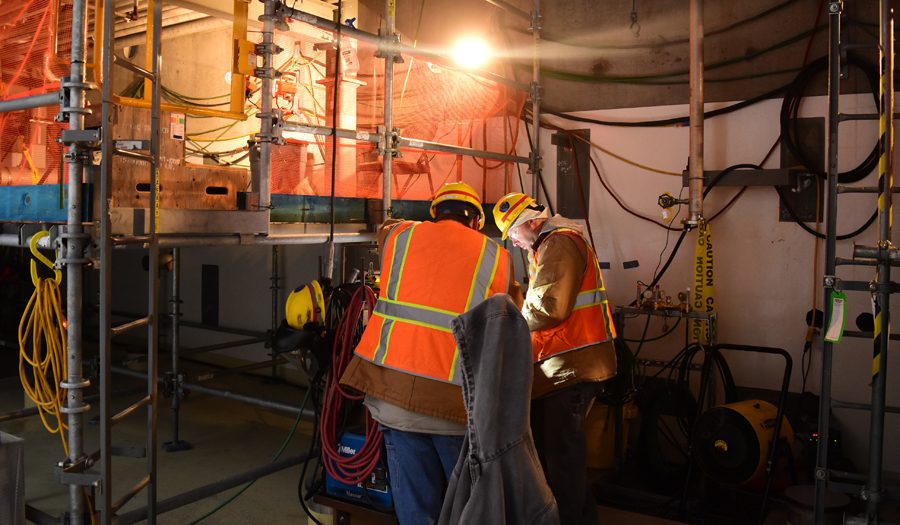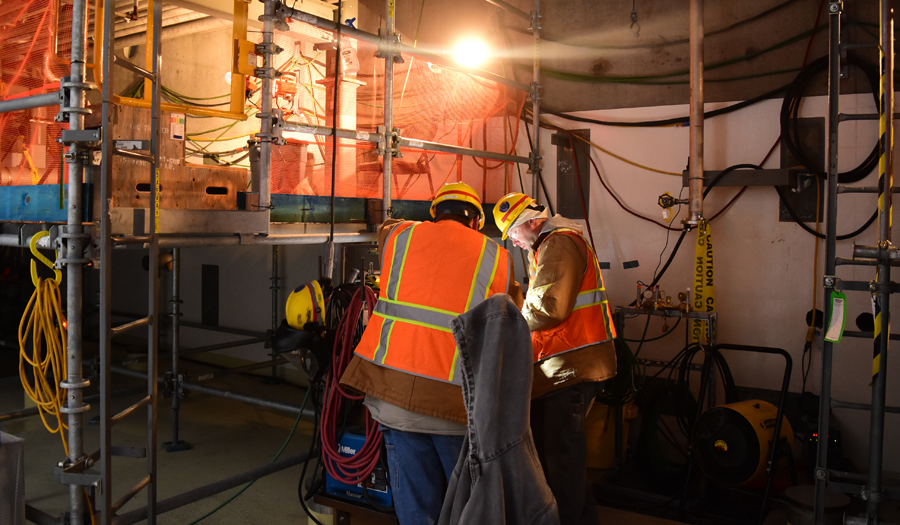
Home » DOE looks to way to replace outgoing workers
DOE looks to way to replace outgoing workers

May 16, 2019
Hanford’s workforce is made up of more professional support staff than engineers, scientists or technicians.
More than 9,000 people are directly employed with efforts at the Hanford site, based on recent U.S. Department of Energy data. That’s more than the individual population of three neighboring cities: Prosser numbers 6,125, Connell 5,460, and Benton City 3,405.
Employment at Hanford and Pacific Northwest National Laboratory accounted for about 12 percent of total employment across Benton and Franklin counties, based on the most recent data through 2017. This represents about a quarter of the total wages earned in the region, with an average annual wage of $97,000 for jobs related to Hanford and PNNL.
The Hanford site is gearing up for a regional “silver tsunami” that will see thousands of retirements and a turnover in its aging workforce.
Nearly 60 percent of those in jobs connected to Hanford are older than age 50, and more than a third are eligible for workforce retirement within the next five years.
“When we hear the statistics about average age, it is cause for concern,” said David Reeploeg, vice president of federal programs at Tri-City Development Council. “When we think of losing that institutional knowledge, we want to make sure someone can take that and build on it.”
This has created a need for the Department of Energy and its prime contractors to look for ways to replace retirees with a qualified workforce.
The Department of Energy’s Office of River Protection reports efforts to recruit replacement workers include partnering with nearby schools and universities, in addition to holding an annual community forum to build awareness of the workforce needs at the site.
“We want a thoughtful and strategic transition from one generation of Hanford workers to the next,” Reeploeg said.

Under prime contractor Bechtel National Inc., about 2,600 employees work on the project to create the world’s largest radioactive waste vitrification plant. That number is expected to be cut in half as the work transitions from construction and startup to its commissioning phase, which will cover daily operation of the plant.
A workforce described as “steady” is expected to include about 1,500 to 1,800 employees, once direct feed low-activity waste operations begin.
The Department of Energy says its contractors tend to categorize employees into one of nine divisions, with not all nine categories represented by every employer: managers, engineers, scientists, professional administrative staff (accountants, attorneys and human resources), administrative assistants, technicians, health care, union members represented by the Hanford Atomic Metal Trades Council, and union members represented by building and construction trades.
The perception of the Hanford site often includes workers heavy in professions related to science, technology, engineering or math fields. Yet, professional administrative staff often represent the highest number of employees used by prime contractors, with Mission Support Alliance, CH2M Hill Plateau Remediation Co. and Washington River Protection Solutions each dedicating about 20 percent of their workforce to roles like auditors, communications and cost estimators.
Bechtel does not break this number out of its workforce total, instead including these workers in the catch-all category “all others.”
While most WRPS employees fall into the professional support staff category, the contractor employs about the same number of managers as it does engineers, totaling about 375 each as of the end of 2018, or about 16 percent of its workforce.
All contractors are stocked with hundreds of managers, representing 13 percent to 22 percent of their staff, depending on the employer.
Bechtel reported the fewest number of managers, with 365, or 13.6 percent of its staff, while CHPRC is the most top heavy, with 354 managers among its 1,600 employees, or 22 percent.
While the Hanford Waste Treatment and Immobilization Plant remains a hub of new construction, to build both the plant itself and many support buildings, the number of trade workers is the highest for Bechtel across the site’s largest contractors.
The company employs about 1,100 trade workers out of its 2,668 employees, or more than 40 percent of its workforce.
Since MSA holds the contract responsible for security and infrastructure at the site, it also employs a high number of people in trade or craft jobs. A quarter of MSA’s workforce is comprised of roles like pipe fitters, welders, electricians, crane operators and other similar roles.
Many of those in trade or craft roles are represented by labor groups, including those employed with CHPRC, MSA, WRPS, Bechtel and Veolia Nuclear Solutions-Federal Services.
In year-end 2018 totals, union-represented employees made up about 42 percent of the workforce for CHPRC and MSA, two contractors under the Department of Energy’s Richland Operations Office. Thirty-eight percent of the representation comes from the Hanford Atomic Metal Trades Council, while MSA is the only Department of Energy prime contractor with workers covered by the Hanford Guards Union.
Another 5,000 employees are working for those contracted with the Department of Energy’s Office of River Protection, including employees with WRPS, Veolia and Bechtel. Each contractor has union-represented workers, including members of both HAMTC and the building and construction trades. The split is a 2-to-1 ratio, non-union versus union.
Union employees for WRPS and Wastren Advantage Inc. are represented by the Hanford Atomic Metal Trades Council, and account for about 42 percent of the overall workforce for WRPS and Veolia.
Bechtel/Waste Treatment Completion Co. employees have union representation from the building and construction trades, and are employed by WTCC. About 30 percent of those working on the vit plant are represented by the 16 union affiliates that make up the building and construction trades.
While most people working on the Hanford site are employed by a private contractor, there are about 360 who work directly for the federal government and are employed by the Department of Energy. More than half are at the Richland Operations Office, with the remaining 150 at the Office of River Protection.
The contractors employing the fewest number of employees at the site include the 80 who work for HPM Corp. and the five dozen who work for Veolia. HPM has held the contract to provide occupational medical services at the site since 2012.
Workers at Veolia are responsible for testing samples from the tank farms. The French company acquired Ohio-based Wastren Advantage, which has held the contract for the 222-S Analytical Laboratory Services since 2015. It employs 63 people at its Richland location. Neither HPM nor Veolia responded to requests for the classification of its employees, totaling just fewer than 150 people.
Collectively, jobs connected to Hanford remain the largest source of employment in the Tri-Cities.
A report from the Pacific Northwest National Laboratory done in 2009 found that jobs at Hanford represented 16 percent of total jobs in the local economy between 1970-94. The same report recalled downsizing at the site in the mid-’90s that reduced employment from a peak of 14,462 in 1996, to 6,706 in 1998. Today’s numbers hover just over 9,000, which doesn’t include the 1,100 workers at Energy Northwest or the 4,500 at PNNL, which puts Battelle atop the list of the largest employers in the Tri-Cities.
Since work first got underway at the Hanford site in the 1940s, the intention of the workforce has shifted as the decades rolled on, resulting in today’s overall focus on cleanup. Yet after more than 75 years of concentrated progress at the site, the demand for a constant workforce has not changed and is expected to remain for decades to come.
“A person graduating from high school or college soon could still have a long and successful career at Hanford,” Reeploeg said.
Local News Hanford
KEYWORDS may 2019





